Apple's iPhone 4: Thoroughly Reviewed
by Brian Klug & Anand Lal Shimpi on June 30, 2010 4:06 AM EST- Posted in
- Smartphones
- Apple
- iPhone 4
- Gadgets
- Mobile
I'm not sure how this keeps happening. The first year I waited at a mall for 5 hours to get the original iPhone. The following year my friend Mark Rein convinced me to see a midnight showing of Hellboy II and then wait outside of an AT&T store all night to get the iPhone 3G. You'd think I'd learn by the third year but once more I was in line at the mall hours before the Apple store opened to get the 3GS. This year I thought it would be different. Apple offered free overnight shipping to anyone who wanted to pre-order the iPhone 4. Figuring everyone would go that route I decided to beat the FedEx trucks and just show up at the mall at 6AM. I'd be in and out in a little over an hour, which would give me a head start on battery life testing on Apple's 4th generation iPhone.
I promise that not all of my decisions play out this poorly. Those who pre-ordered the 4 and requested overnight delivery got their phones early and my one hour wait turned into six hours at the mall, for the fourth year in a row.
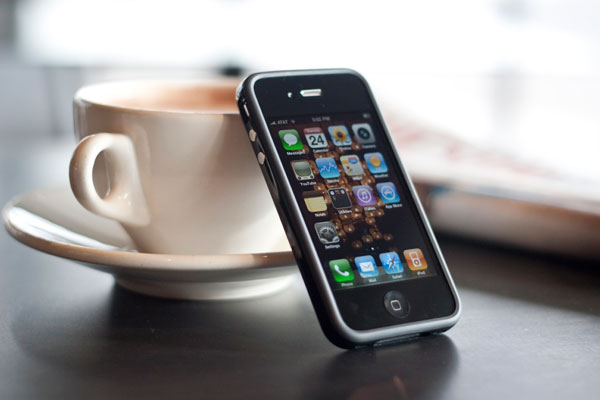
Apple's iPhone 4 with Bumper Case
It's a self fulfilling prophecy. Steve gets up on stage, proclaims the iPhone 4 to be the biggest introduction since the original iPhone, and the public flocks to Apple stores to fork over $200 on day one and around $2500 over the course of two years for the privilege. But this isn't 2007. Apple has real competitors in the smartphone space. Android phones have grown in features, polish and popularity. Even Palm entered the race with a competant offering, and Microsoft isn't far behind. It's easy to start a revolution when everyone else is doing the wrong thing, but what about when more companies actually get it? Was Steve justified in his excitement over the 4? That's what we're here to find out today.
Straight on it looks like just another iPhone. You get the black face with a shiny trim. From the side it is the redesign that Apple has needed for a while now. It’s not revolutionary but it’s the type of improvement that makes its predecessor feel old. And that’s exactly what this does. Have a look for yourself:
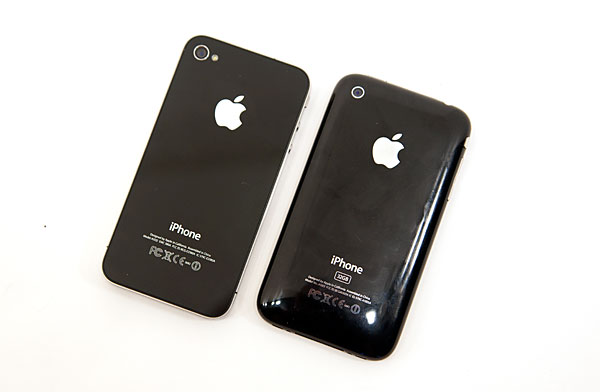
iPhone 4 (left) vs. iPhone 3GS (right)
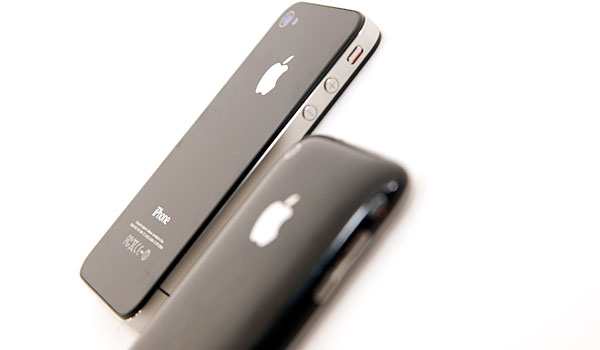
The straight lines, smaller dimensions and lack of unnecessary bulk make the 3GS feel like a car from the 90s, unnecessarily curvy. The styling is now so much more compact. Compared to the iPhone 3GS the 4 is around 5% narrower (but no more difficult to type on) and nearly 25% thinner. It even makes the Nexus One look dated:
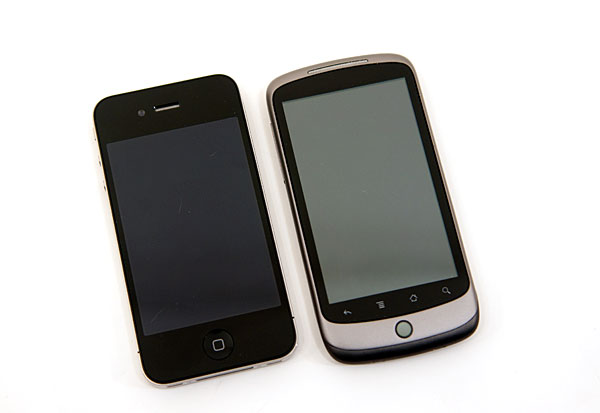
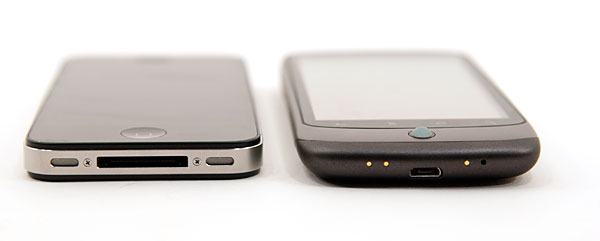
The iPhone 4 is slightly heavier than the 3GS (4.8oz vs. 4.7oz). You feel the added weight but I wouldn't call it heavy. The front and the back of the iPhone 4 are both made out of glass, and they protrude beyond the stainless steel band that wraps around the phone (more on this controversial decision later). While this gives the 4 an amazing finish, it also makes carrying the phone nerve racking. Coupled with the smaller, more dense form factor I’m now deathly afraid of dropping and shattering this thing. Apple has done a lot to reinforce the glass, however there have been enough reports already of shattered iPhone 4s for me not to feel very safe. Only Apple would think to make the two surfaces most likely to hit something out of glass. It's like making mouse traps out of cheese, something bad is bound to happen.
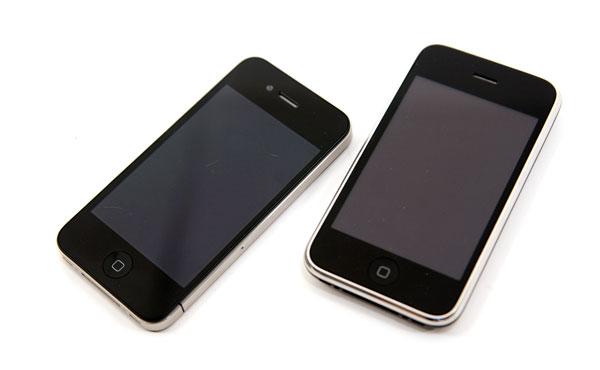
iPhone 4 (left) vs. iPhone 3GS (right)
The physical buttons (but not their layout) have changed on the 4. The ringer switch has shorter travel and feels sturdier as a result. The volume rocker has been replaced by discrete volume up/down buttons, also very sturdy in feel. The power/lock button is also now made out of stainless steel. Only the home button remains unchanged, although it does seem to make a deeper click when you use it.

The speaker moved to behind the right grill at the bottom of the phone instead of the left. The dock connector thankfully remained unchanged. It looks like Apple is committed to maintaining this connector until it makes the jump to something wireless (or optical?).

The back of the phone is pretty. Apple broke with tradition and finally included a single LED flash on the phone. The flash comes on in low light conditions and is enough to take shots in total darkness.
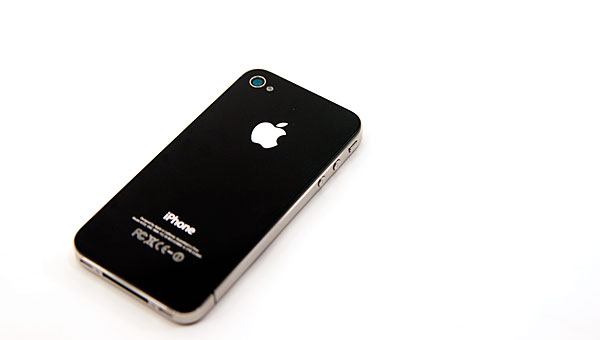
The camera has been upgraded to a low noise 5MP sensor. It can shoot stills at up to 2592 x 1936 or video at 1280 x 720 @ 30 fps. We’ll go into greater detail on its quality in the camera section. The iPhone 4 also adds a front facing camera capable of shooting both photos and video at 640 x 480.
Apple quotes contrast ratio as 1000:1, in our measurements we got very close (952:1). A significant improvement over the 188:1 ratio of the 3GS. Apple achieved this by both dropping black levels and increasing the white levels on the display. Improving both is always fine by me.
Internally the iPhone 4 uses Apple's new A4 SoC, built around an ARM Cortex A8 CPU and a PowerVR SGX GPU. The new SoC is built on a 45nm process and features 512MB of memory on the package. Apple hasn't made CPU clock speed public, but I'm guessing around 800MHz compared to the iPad's 1GHz for reasons you'll see later. GPU clock speed is unknown as well. Having more memory on package is an interesting move by Apple as it makes the iPhone 4 better suited for multitasking compared to the iPad. Also implying that shortly after the iPad gets multitasking it'll be updated to a version with more memory as well.
The iPhone now has an gyroscope as well the rotation sensors of its predecessors. Developers are given full access to the gyroscope making the iPhone 4 capable of becoming a very expensive Wii-mote.
| Physical Comparison | ||||||||
| Apple iPhone 4 | Apple iPhone 3GS | HTC EVO 4G (Qualcomm Snapdragon QSD8650) | HTC Droid Incredible (Qualcomm Snapdragon QSD8650) | Google Nexus One (Qualcomm Snapdragon QSD8250) | ||||
| Height | 115.2 mm (4.5") | 115 mm (4.5") | 121.9 mm (4.8") | 117.5 mm (4.63") | 119 mm (4.7") | |||
| Width | 58.6 mm (2.31") | 62.1 mm (2.44") | 66.0 mm (2.6") | 58.5 mm (2.30") | 59.8 mm (2.35") | |||
| Depth | 9.3 mm ( 0.37") | 12.3 mm (0.48") | 12.7 mm (0.5") | 11.9 mm (0.47") | 11.5 mm (0.45") | |||
| Weight | 137 g (4.8 oz) | 133 g (4.7 oz) | 170 g (6.0 oz) | 130 g (4.6 oz) | 130 g (4.6 oz) | |||
| CPU | Apple A4 @ ~800MHz | Apple/Samsung A3 @ 600MHz | Qualcomm Scorpion @ 1GHz | Qualcomm Scorpion @ 1GHz | Qualcomm Scorpion @ 1GHz | |||
| GPU | PowerVR SGX 535 | PowerVR SGX 535 | Adreno 200 | Adreno 200 | Adreno 200 | |||
| RAM | 512MB LPDDR1 (?) | 256MB LPDDR1 | 512MB LPDDR1 | 512MB LPDDR1 | 512MB LPDDR1 | |||
| NAND | 16GB or 32GB integrated | 16 or 32GB integrated | 8GB micro SD | 8GB micro SD | micro SD | |||
| Camera | 5MP with LED Flash + Front Facing Camera | 3MP | 8MP with dual LED Flash + Front Facing Camera | 8MP with LED Flash | 5MP with LED Flash | |||
| Screen | 3.5" 640 x 960 LED backlit LCD | 3.5" 320 x 480 | 4.3" 480 x 800 | 3.7" 480 x 800 AMOLED | 3.7" 480 x 800 AMOLED | |||
| Battery | Integrated 5.254Whr | Integrated 4.51Whr | Removable 5.5Whr | Removable 4.81 Whr | Removable 5.18 Whr | |||
The iPhone 4's logic board shrinks in size thanks to further component integration, making room for a much larger battery. The 5.25Whr battery in the iPhone 4 is a 16% increase from what was in the 3GS, and 95% of what HTC put in the EVO 4G. While raw performance improved, it's clear that Apple's focus this time around was battery life. Again, we'll dive into specifics later in the review.
Moving back outside Apple surrounded the phone with a stainless steel band. This band doubles as the 3G, WiFi and Bluetooth antennas. And if you hadn't noticed, it also moonlights as a giant elephant. Let's talk about it.










270 Comments
View All Comments
The0ne - Wednesday, June 30, 2010 - link
Actually, Anand likes the performance of the iPhone and i don't blame him. It is smooth, well implemented and thus makes using it more enjoyable, quantifiable or not. Features be damn, what counts is how a user perceives the device he/she is using. And once attached or rather use to them it's hard to like something that isn't the same or better.For the most part, android OS and WebOS are fine for the vast majority of users. The slight sluggish performance is really not hindering anyone from doing anything practical. It is really just a matter of perception.
As for features and design, I can honestly say unless you been in the design phase yourself many decisions are made prior to production. Missing features such as Flash memory support is a choice left out purposely. Don't kid yourself they are doing it because they either can't or because of lack of money/resources.
mesiah - Thursday, July 1, 2010 - link
I don't agree with the flash memory support. Flash memory is so cheap to implement that it comes on the cheapest of cheap products. And before anyone uses the excuse of "a flash port would clutter up the phone and make it look ugly" Look at the huge ugly connector port used to sync / dock an iphone. Compare that to micro usb. You don't think they could shrink that thing to a quarter of its current size, or less, and add in a flash memory port? Hell, A smart engineer could make a docking port that doubles as a flash memory port (makes me wonder why we haven't seen this yet.) The reason you don't get upgradeable flash memory is the same reason you don't get removeable batteries. There isn't money in batteries and memory, the money is in forcing people with outdated hardware to upgrade.The0ne - Thursday, July 1, 2010 - link
Err, I think u might has misread what I was trying to say. As you've stated flash memory support is very easy and cheap to design in. For Apple not to have it means they have purposely decided against it. For example, creative labs has flash support on some of their PMP devices but it is extremely poor in design that it's unusable. That's the other caveat to just putting features in and not properly supporting it.Anand Lal Shimpi - Wednesday, June 30, 2010 - link
By feature parity I was referring to what's new that made it into iPhone 4: higher res screen, 45nm SoC, much improved battery life, smaller form factor. I'd expect that within the next 6 - 12 months we will see Android phones with similar specs.Software feature wise, Android is at parity in most cases and far ahead in others.
Take care,
Anand
darwinosx - Wednesday, June 30, 2010 - link
They you don't know much about either Android, the iPhone 4, or both.Mumrik - Friday, July 2, 2010 - link
Are you aware that your username undermines every single pro Apple comment you make?Also, I think most of us will take Anand's word for it over an anonymous commenter's.
mmike70 - Sunday, July 4, 2010 - link
Why does it undermine?John Sawyer - Thursday, July 1, 2010 - link
The somewhat larger number of pixels in the Retina display that Apple is using in the iPhone 4, plus its smaller size than the Evo and Droid X displays, do combine to make for a massive difference, as the pictures in the article show. I've compared the two, and the iPhone 4 display really is startlingly good. Many things don't look hugely different between the two, such as some videos, larger graphics and text, etc., but small text (which I look at a lot because that's what a lot of websites serve up) certainly does.semo - Wednesday, June 30, 2010 - link
I'm sorry Anand but I just couldn't bring my self to read your review after yet again detecting your bias towards this product. You come from an engineering background and it shows in your methods of analysis which appeals to me.Do you wait 6 hours in line for a new SSD? I detect hints of emotion in this article's introduction. I could be wrong but I always try to avoid technical reading when I suspect there is bias. It is plain to see on other technical sites where the companies' mission statement is part of the introduction but much more subtle here.
I look forward to your next SSD and chip architecture articles.
bplewis24 - Wednesday, June 30, 2010 - link
Anand is about the most objective Apple iPhone fanboy there is. There is no denying this, and it's both a compliment and a criticism. Until he can stop making subjective generalizations like this:"There is this more open, more configurable, more capable feel you get with Android that you don't with the iPhone. That can be both a positive and a negative. Android phones feel more like computers while iPhones have more of that appliance feel. It still boils down to personal preference, the 4 won't change that."
Really, Anand? Being more open and configurable can be a bad thing? We really need to stop perpetuating this myth that Androids can only be liked by "PC" geeks and people who like to dig deep into the OS. The reality is that Android devices don't force you to customize if you don't want to.
I'm also fairly certain that the "scrolling" issue which isn't present on my Moto Droid has something to do with the live wallpapers eating up CPU processing power. Nevertheless, I don't experience it on my phone and to blanketly imply that the OS UI is clunky (which most iPhone fanboys cling to in every comparison) is completely disingenuous.
Until Anand can rid himself of some of this bias, he will still be known as the best and most objective iPHone reviewer on the interwebs, but the title in and of itself won't be saying very much.
Brandon